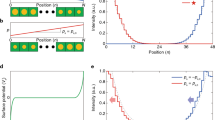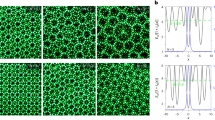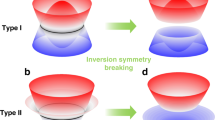Abstract
In three-dimensional (3D) photonic crystals1,2,3,4,5,6,7,8,9,10,11,12, refractive-index variations with a periodicity comparable to the wavelength of the light passing through the crystal give rise to so-called photonic bandgaps, which are analogous to electronic bandgaps for electrons moving in the periodic electrostatic potential of a material’s crystal structure. Such 3D photonic bandgap crystals are envisioned to become fundamental building blocks for the control and manipulation of photons in optical circuits. So far, such schemes have been pursued by embedding artificial defects3,4,5,8,9,10,11,12 and light emitters4,5,6,7,8,9 inside the crystals, making use of 3D bandgap directional effects. Here we show experimentally that photons can be controlled and manipulated even at the ‘surface’ of 3D photonic crystals, where 3D periodicity is terminated, establishing a new and versatile route for photon manipulation. By making use of an evanescent-mode coupling technique, we demonstrate that 3D photonic crystals possess two-dimensional surface states, and we map their band structure. We show that photons can be confined and propagate through these two-dimensional surface states, and we realize their localization at arbitrary surface points by designing artificial surface-defect structures through the formation of a surface-mode gap. Surprisingly, the quality factors of the surface-defect mode are the largest reported for 3D photonic crystal nanocavities (Q up to ∼9,000). In addition to providing a new approach for photon manipulation by photonic crystals, our findings are relevant for the generation and control of plasmon-polaritons in metals and the related surface photon physics. The absorption-free nature of the 3D photonic crystal surface may enable new sensing applications and provide routes for the realization of efficient light–matter interactions.
This is a preview of subscription content, access via your institution
Access options
Subscribe to this journal
Receive 51 print issues and online access
$199.00 per year
only $3.90 per issue
Buy this article
- Purchase on Springer Link
- Instant access to full article PDF
Prices may be subject to local taxes which are calculated during checkout




Similar content being viewed by others
References
Yablonovitch, E. Inhibited spontaneous emission in solid-state physics and electronics. Phys. Rev. Lett. 58, 2059–2062 (1987)
John, S. Strong localization of photons in certain disordered dielectric superlattices. Phys. Rev. Lett. 58, 2486–2489 (1987)
Noda, S., Tomoda, K., Yamamoto, N. & Chutinan, A. Full three-dimensional photonic bandgap crystals at near-infrared wavelengths. Science 289, 604–606 (2000)
Noda, S., Fujita, M. & Asano, T. Spontaneous-emission control by photonic crystals and nanocavities. Nature Photon. 1, 449–458 (2007)
Ogawa, S., Imada, M., Yoshimoto, S., Okano, M. & Noda, S. Control of light emission by 3D photonic crystals. Science 305, 227–229 (2004)
Lodahl, P. et al. Controlling the dynamics of spontaneous emission from quantum dots by photonic crystals. Nature 430, 654–657 (2004)
Li, J., Jia, B., Zhou, G. & Gu, M. Direction-dependent spontaneous emission from near-infrared quantum dots at the angular band edges of a three-dimensional photonic crystal. Appl. Phys. Lett. 91, 254101 (2007)
Ogawa, S., Ishizaki, K., Furukawa, T. & Noda, S. Spontaneous emission control by 17 layers of three-dimensional photonic crystals. Electron. Lett. 44, 377–378 (2008)
Aoki, K. et al. Coupling of quantum-dot light emission with a three-dimensional photonic-crystal nanocavity. Nature Photon. 2, 688–692 (2008)
Qi, M. et al. A three-dimensional optical photonic crystal with designed point defects. Nature 429, 538–542 (2004)
Rinne, S. A., García-Santamaría, F. & Braun, P. V. Embedded cavities and waveguides in three-dimensional silicon photonic crystals. Nature Photon. 2, 52–56 (2008)
Imada, M., Lee, L. H., Okano, M., Kawashima, S. & Noda, S. Development of three-dimensional photonic-crystal waveguides at optical-communication wavelengths. Appl. Phys. Lett. 88, 171107 (2006)
Meade, R. D., Brommer, K. D., Rappe, A. M. & Joannopoulos, J. D. Electromagnetic Bloch waves at the surface of a photonic crystal. Phys. Rev. B 44, 10961–10964 (1991)
Ho, K. M., Chan, C. T., Soukoulis, C. M., Biswas, R. & Sigalas, M. Photonic band gaps in three dimensions: new layer-by-layer periodic structures. Solid State Commun. 89, 413–416 (1994)
Sözüer, H. S. & Dowling, J. P. Photonic band calculations for woodpile structures. J. Mod. Opt. 41, 231–239 (1994)
Yamamoto, N., Noda, S. & Chutinan, A. Development of one period of a three-dimensional photonic crystal in the 5–10 μm wavelength region by wafer fusion and laser beam diffraction pattern observation techniques. Jpn. J. Appl. Phys. 37, L1052–L1054 (1998)
Kawashima, S., Imada, M., Ishizaki, K. & Noda, S. High-precision alignment and bonding system for the fabrication of 3-D nanostructures. J. Microelectromech. Syst. 16, 1140–1144 (2007)
Astratov, V. N. et al. Photonic band-structure effects in the reflectivity of periodically patterned waveguides. Phys. Rev. B 60, R16255–R16258 (1999)
Coquillat, D. et al. Equifrequency surfaces in a two-dimensional GaN-based photonic crstal. Opt. Express 12, 1097–1108 (2004)
Paraire, N. & Banachour, Y. Investigation of planar photonic crystal band diagrams under the light cone using surface coupling techniques. Appl. Phys. B 89, 245–250 (2007)
Otto, A. Excitation of nonradiative surface plasma waves in silver by the method of frustrated total reflection. Z. Phys. 216, 398–410 (1968)
Kretschmann, E. & Raether, H. Radiative decay of nonradiative surface plasmons excited by light. Z. Naturforsch. 23a, 2135–2136 (1968)
Tien, P. K., Ulrich, R. & Martin, R. J. Modes of propagating light waves in thin deposited semiconductor films. Appl. Phys. Lett. 14, 291–294 (1969)
Galli, M. et al. Excitation of radiative and evanescent defect modes in linear photonic crystal waveguides. Phys. Rev. B 70, 081307 (2004)
Yee, K. S. Numerical solution of initial boundary value problems involving Maxwell’s equations in isotropic media. IEEE Trans. Antenn. Propag. 14, 302–307 (1966)
Mur, G. Absorbing boundary conditions for the finite-difference approximation of the time-domain electromagnetic-field equations. IEEE Trans. Electromagn. Compat. 23, 377–382 (1981)
Berenger, J. P. A perfectly matched layer for the absorption of electromagnetic waves. J. Comput. Phys. 114, 185–200 (1994)
Acknowledgements
We thank Q. Sun for assistance with the experiment and numerical analysis, and S. Kawashima, S. Takahashi, Y. Tanaka, T. Asano and M. Fujita for discussions and advice. This work was supported in part by the Global Centre of Excellence for Education and Research on Photonics and Electronics Science and Engineering of Kyoto University, Japan, and by Grants-in-Aid for Scientific Research of the Ministry of Education, Culture, Sports, Science and Technology of Japan, and the Japan Society for the Promotion of Science (JSPS). K.I. acknowledges support from a Research Fellowship of the JSPS.
Author Contributions S.N. planned and organized the project; K.I. conducted the calculations, fabrications and measurements; S.N. and K.I. discussed the results and wrote the manuscript.
Author information
Authors and Affiliations
Corresponding author
Supplementary information
Supplementary Figure
This file contains Supplementary Figure S1 with legend. (PDF 318 kb)
Rights and permissions
About this article
Cite this article
Ishizaki, K., Noda, S. Manipulation of photons at the surface of three-dimensional photonic crystals. Nature 460, 367–370 (2009). https://doi.org/10.1038/nature08190
Received:
Accepted:
Issue Date:
DOI: https://doi.org/10.1038/nature08190
This article is cited by
-
Three-dimensional photonic topological insulator without spin–orbit coupling
Nature Communications (2022)
-
Reconfiguration of three-dimensional liquid-crystalline photonic crystals by electrostriction
Nature Materials (2020)
-
Fabrication of Nanoshell-Based 3D Periodic Structures by Templating Process using Solution-derived ZnO
Nanoscale Research Letters (2017)
-
Type-II Dirac photons
npj Quantum Materials (2017)
-
Demonstration of a refractometric sensor based on an optical micro-fiber three-beam interferometer
Scientific Reports (2014)
Comments
By submitting a comment you agree to abide by our Terms and Community Guidelines. If you find something abusive or that does not comply with our terms or guidelines please flag it as inappropriate.



